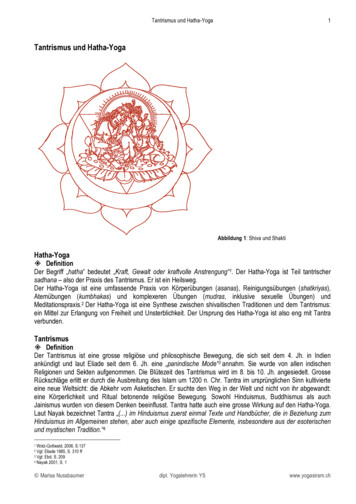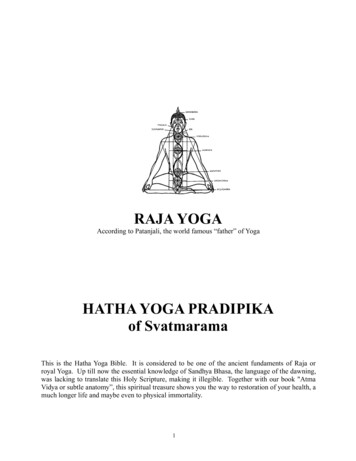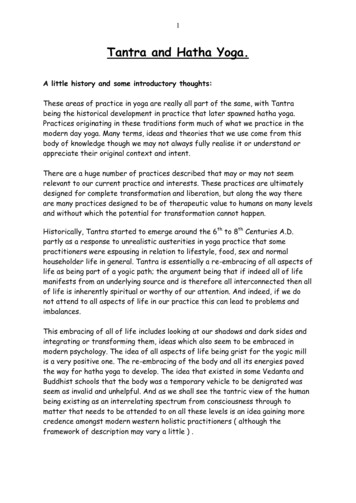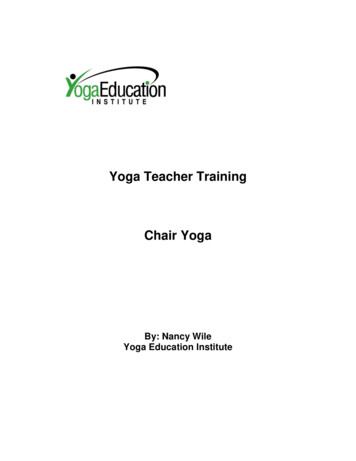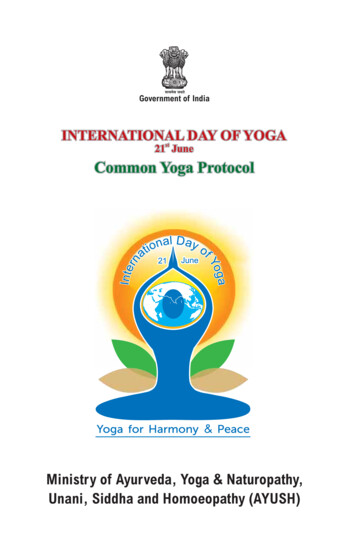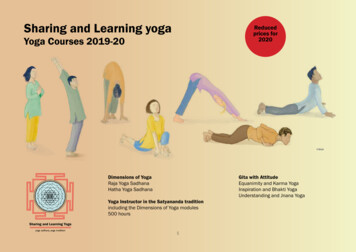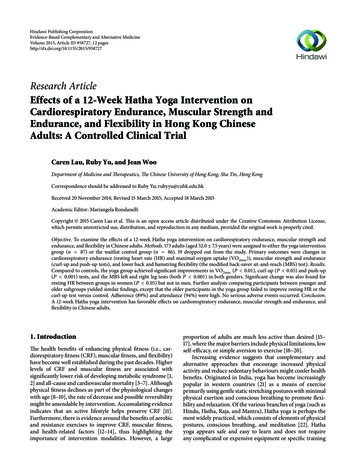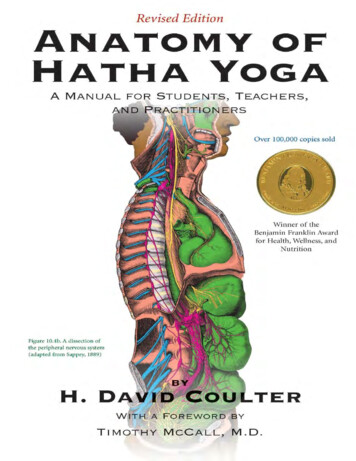
Transcription
ANATOMYOFHATHA YOGA
ANATOMYOFHATHA YOGAA Manual for Students, Teachers, and PractitionersbyH. David CoulterForewordbyTimothy McCall, M. D.Body and BreathHonesdale, PA, USA
Text and illustrations 2001 by H. David CoulterForeword 2001 by Timothy McCallBody and Breath, Inc., 2114 Ames Hill Rd., Marlboro, VT 05344 USA2017 2016 2015 2014 2013 2012 2011 201017 16 15 14 13 12 11 10 9 8PRECAUTIONARY NOTE: This is not a medical text, but a compendium of remarks concerning how anatomy and physiology relateto hatha yoga. Any medical questions regarding contraindications and cautions or any questions regarding whether or not to proceedwith particular practices or postures should be referred either to health professionals who have an interest in medical problemsassociated with exercise, stretching, and breathing, or to hatha yoga teachers who have had experience working with medical problemsin a therapeutic setting supervised by health professionals.All rights reserved. With certain exceptions enumerated below, no part of this book may be reproduced, stored in a retrieval system, ortransmitted in any form or by any means—electronic, mechanical, photocopying, recording, or otherwise—without written permissionfrom the publisher. There are three exceptions. First: brief quotations of up to words that are embodied in critical articles and reviews canbe used freely so long as they are properly acknowledged. Second: blanket permission is granted for institutional and individualphotocopying, properly acknowledged, of up to one hundred copies totaling no more than 25,000 words for each copy with accompanyingillustrations (approximately one chapter), or alternatively, a series of extracts from the entire book totaling no more than 25,000 words, forpurposes of teaching or for research and private study, excepting that no deletions, alterations, or exclusions within individual pages arepermitted. For example: cutting and pasting of illustrations for student syllabi is expressly forbidden. Only individual pages in theirentirety are to be photocopied, including text (if any) and all running heads, captions, and labels that are incorporated within each page.Third: permission for scanning of text, halftones, anatomical drawings, charts, and tables (either in isolation or altered as desired) isgranted only for trials of electronic or hard copy publishing layouts; permission must be sought from the publisher (Body and Breath Inc.)to use such illustrations for any kind of electronic or mechanical transmission or in other publications. Printed in China.Library of Congress Cataloging-in-Publication DataCoulter, H. David (Herbert David), 1939–Anatomy of Hatha Yoga : a manual for students, teachers, and practitioners / byH. David Coulter ; foreword by Timothy McCall.p. cm.Includes bibilographical references and index.eISBN 97809707006291. Yoga, Hatha—Physiological aspects. 2. Human mechanics. 3. Human anatomy.I. Title.RA 781.7.C685 2001613.7’046—dc212001025691
To my parents, who guided me lovingly, watched my life with joy and enthusiasm, supported myacademic and personal interests, and always thought the best of me.
“Why do you never find anything written about that idiosyncratic thought you advertto, about your fascination with something no one else understands? Because it is upto you. There is something you find interesting, for a reason hard to explain. It is hardto explain because you have never read it on any page; there you begin. You weremade and set here to give voice to this, your own astonishment.”— Annie Dillard, in The Writing Life
CONTENTSForewordPrefaceIntroductionBasic PremisesChapter One - MOVEMENT AND POSTUREThe Neuro-musculoskeletal SystemThe Nervous SystemReflexesThe Vestibular System, Sight, and TouchConnective Tissue RestraintsStretchingThree PosturesPutting It All TogetherChapter Two - BREATHINGThe Design of the Respiratory SystemThe Muscles of RespirationHow Breathing Affects PostureThe Somatic and Autonomic SystemsThe Physiology of RespirationThoracic BreathingParadoxical BreathingSupine Abdominal BreathingAbdominal Breathing in Sitting PosturesDiaphragmatic BreathingA Traditional WarningChapter Three - ABDOMINOPELVIC EXERCISESCrunches and Sit-upsThe Foundation of the BodySupine Leg LiftsYoga Sit-upsThe Sitting Boat PosturesThe PeacockThe Pelvis and The Anatomical PerineumAshwini MudraMula BandhaAgni SaraUddiyana Bandha, The Abdominal LiftNauliContraindicationsBenefitsChapter Four - STANDING POSTURESThe Skeletal System and MovementAnatomy of the SpineSymmetry and AsymmetryStanding PosturesFour Simple Stretches
Backward BendingForward BendingSide BendingWhat Makes Postures Difficult?The Triangle PosturesTwo Balancing PosturesBenefitsChapter Five - BACKBENDING POSTURESThe Anatomy of Flexion and ExtensionBreathing and BackbendingThe Cobra PosturesThe Locust PosturesThe Prone Boat PosturesThe Bow PosturesThe Knee JointSupine Backbending PosturesA Kneeling Backbend—The CamelContraindicationsBenefitsChapter Six - FORWARD BENDING POSTURESForward Bending: Head, Neck, and ChestLumbar and Lumbosacral Forward BendingSacroiliac Nutation and CounternutationForward Bending at the Hip JointsForward Bending at the Ankles and in the FeetClinical Matters and CautionsThe Posterior StretchThe Down-Facing DogThe Child’s PoseBreathing and Forward BendingSacroiliac FlexibilityHip FlexibilityBenefitsChapter Seven - TWISTING POSTURESThe Fundamentals of TwistingThe Skull, the Atlas, and the AxisMovements of the Head and NeckThoracic TwistingLumbar TwistingThe Lower ExtremitiesSupine TwistsStanding TwistsInverted TwistsSitting Spinal TwistsBenefitsChapter Eight - THE HEADSTANDThe Cardiovascular SystemThe Two HeadstandsThe Upper ExtremitiesStructural ImbalancesBreathing IssuesDeveloping Strength and FlexibilityBending and Twisting in the HeadstandExtending Your TimeBenefits
Chapter Nine - THE SHOULDERSTANDAnatomy of The ShoulderstandInverted Action PosturesThe ShoulderstandThe PlowThe Lifted Shoulderstand and PlowCirculationRespirationSequelaeBenefitsChapter Ten - RELAXATION AND MEDITATIONMuscular RelaxationTwo Relaxation PosturesBreathing and RelaxationThe Autonomic Nervous SystemDeepening RelaxationMeditation PosturesMaintaining the GeometryPropsThe Six PosturesMula BandhaMastering the SituationKnower of the VeilGlossaryAdditional SourcesAcknowledgmentsIndex of Anatomical TermsIndex of PracticesBiographical Sketch
FOREWORDHathayoga. Its teachers and serious students are convinced of its power to build strength andconfidence, to improve flexibility and balance, and to foster spiritual peace and contentment. Andbeyond its attributes as preventive medicine, many of us also believe in the power of yoga to heal, to aidin recovering from everything from low back strain to carpal tunnel syndrome and to help cope withchronic problems like arthritis, multiple sclerosis and infection with the human immunodeficiency virus(HIV).But despite the recent boom in yoga’s popularity, most scientists and physicians have been slow toembrace this discipline. To many of them perhaps, it seems like a mystical pursuit, a quasi-religion withlittle basis in the modern world of science. In a medical profession now itself dominated by a nearreligious reverence for the randomized, controlled study, knowledge acquired through thousands ofyears of direct observation, introspection, and trial and error may seem quaint.But as the West has slowly opened in the past decades to Eastern, experientially based fields likeacupuncture—as part of a greater acceptance of alternative medicine in general—yoga has begun tostake its claim. Concepts like prana or chi, however, are not warmly received by skeptical scientists. Towin them over you need to provide the kind of evidence they buy. Studies. Preferably published in peerreview journals. And you need to propose mechanisms of action that conform with science as theyunderstand it.A significant breakthrough was provided by Dr. Dean Ornish, a California-based cardiologist whointerrupted his college years to study with Sri Swami Satchidananda. His work, published in 1990 in theprestigious British medical journal the Lancet, showed that a program that combines hatha yoga withdietary changes, exercise, and group therapy can actually reverse blockages in the heart’s main arteries—which doctors used to think wasn’t possible.In 1998, research led by Marian Garfinkel of the Medical College of Pennsylvania and publishedin the Journal of the American Medical Association found that Iyengar yoga could effectively reducethe symptoms of carpal tunnel syndrome, a malady of near epidemic proportions in this computer age.Of note, Garfinkel’s study lasted only eight weeks, and yet the intervention proved efficacious. Seriousyoga practitioners realize of course that although some benefit may be noticed after even a single class,yoga’s most profound effects accrue over years—even decades—not weeks. Yoga is indeed powerfulmedicine but it is slow medicine.More studies will be needed to convince the medical establishment, but that research could also beslow in coming. Funding is a perennial problem. Unlike the situation with, say, pharmaceuticals, there isno private industry to bankroll the scientific investigation of hatha yoga. Given the incredible cost oflong-range studies—which are more likely to demonstrate effectiveness—I suspect that we’re unlikelyto see any time soon the kind of overwhelming proof that skeptical scientists want. This presents aphilosophical question: When you have an intervention which appears safe and effective—and when itsside effects are almost entirely positive—should one wait for proof before trying it? This valuejudgment lies at the heart of the recent debate over many traditional healing methods.Ironically, though, even within the world of alternative medicine yoga seems under-appreciated.Two years ago, I attended a four-day conference on alternative medicine sponsored by Harvard MedicalSchool. A wide range of topics from herbs to prayer to homeopathy were covered in detail. Yet in thedozens of presentations I attended, yoga was mentioned just once: In a slide that accompanied thelecture on cardiovascular disease, yoga was one of several modalities listed under “Other Stress
Reduction Techniques.” Yoga is certainly a stress reduction device but to reduce it to just that misses somuch.Given the situation, how welcome then is David Coulter’s Anatomy of Hatha Yoga. Davidcombines the perspectives of a dedicated yogi with that of a former anatomy professor and researchassociate at two major American medical schools. He has set himself the ambitious goal of combiningthe modern scientific understanding of anatomy and physiology with the ancient practice of hatha yoga.The result of an obvious labor of love, the book explains hatha yoga in demystified, scientificterms while at the same time honoring its traditions. It should go a long way to helping yoga achieve thescientific recognition it deserves. Useful as both a textbook and as a reference, Anatomy of Hatha Yogais a book that all serious yoga teachers and practitioners will want on their shelves. It will also bewelcomed by sympathetic physicians—and there are more of us all the time—as well as physicaltherapists and other health professionals. Speaking as a doctor who had already studied anatomy indetail (though forgotten more than I’d care to admit) and as a dedicated student of yoga, I can happilyreport that this book heightened my understanding of both hatha yoga and anatomy and—as a nicebonus—improved my personal practice.I realize, however, that to those who lack scientific training Anatomy of Hatha Yoga may seemdaunting. Some sections use terminology and concepts that may be challenging on first reading. If youfeel intimidated, my suggestion is to adopt the mentality many employ when reading the ancient andsometimes difficult texts of the yoga tradition. Read with an open heart and if you get frustrated, tryanother part or come back to it another day. As with yoga itself, diligent students will be rewarded withan ever-greater understanding.Timothy McCall, MDBoston, MassachusettsJanuary, 2001Dr. Timothy McCall is a board-certified specialist in internal medicine and the author of ExaminingYour Doctor: A Patient’s Guide to Avoiding Harmful Medical Care. His work has appeared in more thana dozen major publications including the New England Journal of Medicine, the Nation and the LosAngeles Times. He can be found on the web at www.drmccall.com
PREFACEThe origins of this book date from twenty-five years ago when I was teaching various neuroscience,microscopic anatomy, and elementary anatomy courses in the Department of Cell Biology andNeuroanatomy at the University of Minnesota. At the same time I was learning about yoga in classes atthe Meditation Center in Minneapolis. During those years, Swami Rama, who founded the HimalayanInstitute, often lectured in Minnesota, and one of his messages was that yoga was neither exercise norreligion, but a science, and he wanted modern biomedical science to examine it in that light. One of hispurposes in coming to the West was to bring this about, a purpose which is reflected by the name heselected for the institute that he founded—The Himalayan International Institute of Yoga Science andPhilosophy. The idea of connecting yoga with modern science resonated with me, and the convictiongrew that I could be a part of such a quest. Soon after I communicated my interest, Swamiji called andsuggested that I pay him a visit to talk about writing a book on anatomy and hatha yoga. And that ishow this project began in 1976.Apart from several false starts and near-fatal errors, I did little writing on this subject between1976 and 1988, but still I benefited from students’ questions in courses on anatomy and hatha yoga atthe University of Minnesota (Extension Division), more comprehensive courses on yoga anatomy forgraduate students at the Himalayan Institute in the late 1980s, anatomy and physiology courses in themid-1990s for the Pacific Institute for Oriental Medicine (NYC), and from 1990 to the present, teachinganatomy for students of Ohashiatsu , a method of Oriental bodywork. These courses brought me intouch with many telling questions from students interested in various aspects of holistic medicine;without them, the seed planted by Swamiji would never have matured.And so it went, from a working draft in the summer of 1976 to 1995, when after many gentle andnot-so-gentle nudges, Swamiji insisted that my time was up, I was to finish the book, finish it now, andnot run away. If I tried to escape, he avowed, he would follow me to the ends of the earth; what hewould do upon finding me is better left unsaid. Happily, he saw an early but complete draft of the text ayear before his passing in November of 1996.
INTRODUCTIONA comprehensive statement on the anatomy and physiology of hatha yoga ought to have been writtenyears ago. But it hasn’t happened, and my aim is to remedy the deficiency. After considering the subjectfor twenty-five years, it’s clear that such a work might well interweave two themes: for the benefit ofcompleteness, a traditional treatment of how to do yoga postures (yoga asanas) using anatomicallyprecise terminology, and, for correlations with medical science, an objective analysis of how thosepostures are realized in some of the great systems of the body. In that regard, special emphasis is placedhere on the musculoskeletal, nervous, respiratory, and cardiovascular systems—the musculoskeletalsystem because that is where all our actions are expressed, the nervous system because that is theresidence of all the managerial functions of the musculoskeletal system, the respiratory system becausebreathing is of such paramount importance in yoga, and the cardiovascular system because invertedpostures cannot be fully comprehended without understanding the dynamics of the circulation. Most ofthe emphasis is practical—doing experiments, learning to observe the body, and further refining actionsand observations.The discussion is intended for an audience of yoga teachers, health professionals, and anyone elsewho is interested in exploring some of the structural and functional aspects of hatha yoga. The work canalso serve as a guide for students of alternative medicine who would like to communicate with thosewho place their faith more strictly in contemporary science. To help everyone in that regard I’veincluded only material that is generally accepted in modern biomedical sciences, avoiding comment onnon-physical concepts such as prana, the nadis, and the chakras, none of which are presently testable inthe scientific sense, and none of which have obvious parallels in turn-of-the-millennium biology.The book begins with an introductory discussion of some basic premises that set a philosophicaltone and suggest a consistent mental and physical approach to postures. Ten chapters follow, the firstthree fundamental to the last seven. Chapter 1 summarizes the basic principles of the anatomy andphysiology of hatha yoga. Breathing is next in chapter 2 since the manner in which we breathe in hathayoga is important for expediting movement and posture. Breathing is followed by pelvic and abdominalexercises in chapter 3 for three reasons: many of those exercises use specialized methods of breathing,they are excellent warm-ups for other postures, and the pelvis and abdomen form the foundation of thebody. Standing postures will then be covered in chapter 4 because these poses are so important forbeginning students, and because they provide a preview of backbending, forward bending, and twistingpostures, which are covered in detail in chapters 5, 6, and 7. The headstand and shoulderstand, includinga brief introduction to cardiovascular function, are included in chapters 8 and 9. Postures for relaxationand meditation are treated last in chapter 10.It will be helpful to experiment with each posture, preferably in the order given. This approach willlead you logically through a wealth of musculoskeletal anatomy, bring the academic discourse to life,and permit you to understand the body’s architecture and work with it safely. If some of the sections onanatomy and physiology seem formidable, there is an easy solution. Turn the page. Or turn severalpages. Go directly to the next section on postures, in which most of the discussion can be understood incontext. Just keep in mind, however, that knowledge is power, and that to communicate effectively withlaypeople who have technical questions as well as with health professionals to whom you may go foradvice, it may be desirable to refer back to the more challenging sections of this book as the need arises.And those who do not find these sections particularly demanding can look to Alter’s definitive Scienceof Flexibility, as well as to other sources that are listed after the glossary, if they require more technical
details than are provided here.
BASIC PREMISESThe last half of the twentieth century saw many schools of hatha yoga take root in the West. Some arebased on authentic oral traditions passed down through many generations of teachers. Some are pitchedto meet modern needs and expectations but are still consistent with the ancient art, science, andphilosophy of yoga. Still others have developed New Age tangents that traditionalists view withsuspicion. Picture this title placed near the exit of your local bookstore: Get Rich, Young, and Beautifulwith Hatha Yoga. I’ve not seen it, but it would hardly be surprising, and I have to admit that I wouldlook carefully before not buying it . . . .Given human differences, the many schools of hatha yoga approach even the most basic postureswith differing expectations, and yoga teachers find themselves facing a spectrum of students that rangesfrom accomplished dancers and gymnasts to nursing home residents who are afraid to lie down on thefloor for fear they won’t be able to get back up. That’s fine; it’s not a problem to transcend suchdifferences, because for everyone, no matter what their age or level of expertise, the most importantissue in hatha yoga is not flexibility and the ability to do difficult postures, but awareness—awarenessof the body and the breath, and for those who read this book, awareness of the anatomical andphysiological principles that underlie each posture. From this awareness comes control, and fromcontrol comes grace and beauty. Even postures approximated by beginning students can carry the germof poise and elegance.How to accomplish these goals is another matter, and we often see disagreement over how theposes should be approached and taught. Therefore, the guidelines that follow are not set in stone; theirpurpose is to provide a common point of reference from which we can discuss the anatomy andphysiology of hatha yoga.FOCUS YOUR ATTENTIONLock your attention within the body. You can hold your concentration on breathing, on tissues that arebeing stretched, on joints that are being stressed, on the speed of your movements, or on therelationships between breathing and stretching. You can also concentrate on your options as you movein and out of postures. Practicing with total attention within the body is advanced yoga, no matter howeasy the posture; practicing with your attention scattered is the practice of a beginner, no matter howdifficult the posture. Hatha yoga trains the mind as well as the body, so focus your attention withoutlapse.BE AWARE OF YOUR BREATHWe’ll see in chapters 2–7 that inhalations lift you more fully into many postures and create a healthyinternal tension and stability in the torso. You can test this by lying prone on the floor and noticing thatlifting up higher in the cobra posture (fig. 2.10) is aided by inhalation. Paradoxically, however,exhalations rather than inhalations carry you further into many other postures. You can test this bysettling into a sitting forward bend and noticing that exhalation allows you to draw your chest downcloser to your thighs (fig. 6.13). But in either case you get two benefits: diaphragmatic breathing assiststhe work of stretching the tissues, and your awareness of those effects directs you to make subtleadjustments in the posture.While doing postures, as a general rule keep the airway wide open, breathe only through the nose,
and breathe smoothly, evenly, and quietly. Never hold the breath at the glottis or make noise as youbreathe except as required or suggested by specific practices.BUILD FOUNDATIONSAs you do each asana, analyze its foundation in the body and pinpoint the key muscles that assist inmaintaining that foundation: the lower extremities and their extensor muscles in standing postures; theshoulders, neck, spine (vertebral column), and muscles of the torso in the shoulderstand; and theentirety of the musculoskeletal system, but especially the abdominal and deep back muscles, in thepeacock. Focus your attention accordingly on the pertinent regional anatomy, both to prevent injury andto refine your understanding of the posture.Then there is another kind of foundation, more general than what we appreciate from the point ofview of regional anatomy—the foundation of connective tissues throughout the body, especially thosethat bind the musculoskeletal system together. The connective tissues are like steel reinforcing rods inconcrete; they are hidden but intrinsic to the integrity of the whole. To strengthen these tissues inpreparation for more demanding work with postures, concentrate at first on toughening up jointcapsules, tendons, ligaments, and the fascial sheathes that envelop muscles. The practical method foraccomplishing these aims is to build strength, and to do this from the inside out, starting with the centralmuscles of the torso and then moving from there to the extremities. Aches and pains frequently developif you attempt extreme stretches before you have first developed the strength and skill to protect the allimportant joints. Unless you are already a weightlifter or body builder, stretching and becoming flexibleshould be a secondary concern. Only as your practice matures should your emphasis be changed tocultivate a greater range of motion around the joints.MOVING INTO AND OUT OF POSTURESBeing in a state of silence when you have come into a posture is soothing and even magical, but youcannot connect with that state except by knowing how you got there and knowing where you’re going.If you jerk from posture to posture you cannot enjoy the journey, and the journey is just as important asthe destination. So move into and out of postures slowly and consciously. As you move, survey thebody from head to toe: hands, wrists, forearms, elbows, arms, and shoulders; feet, ankles, legs, knees,thighs, and hips; and pelvis, abdomen, chest, neck, and head. You will soon develop awareness of howthe body functions as a unit and notice quirks and discontinuities in your practice which you can thensmooth out. Finally, as you learn to move more gracefully, the final posture will seem less difficult.HONOR THE SUGGESTIONS OF PAINDo you honor or ignore messages from aches and pains? If you have back pain, do you adjust yourposture and activities to minimize it, or do you just tough it out? And do you keep a deferential eye onyour body, or do you find that you get so wrapped up in some challenge that you forget about it? If youdo not listen to messages from your body you will be a candidate for pulled muscles, tendinitis, pinchednerves, and ruptured intervertebral disks. To avoid injury in hatha yoga you have to develop a selfrespecting awareness.Begin your program of hatha yoga with a resolution to avoid pain. Unless you have had years ofexperience and know exactly what you are doing, pushing yourself into a painful stretch will not onlycourt injury, it will also create a state of fear and anxiety, and your nervous system will store thosememories and thwart your efforts to recreate the posture. Pain is a gift; it tells us that some problem hasdeveloped. Analyze the nature of the problem instead of pushing ahead mindlessly. With self-awareness
and the guidance of a competent teacher, you can do other postures that circumvent the difficulty.CULTIVATE REGULARITY, ENTHUSIASM, AND CAUTIONTry to practice at the same time and in the same place every day. Such habits will make it easier toanalyze day-to-day changes. Mornings are best for improving health—stiffness in the early morningtells you where you need the most careful work and attention. Later in the day, you lose that sensitivityand incur the risk of injury. Cultivate a frolicsome enthusiasm in the morning to counter stiffness, andcautiousness in the evening to avoid hurting yourself. And at any time, if you start feeling uncommonlystrong, flexible, and frisky, be careful. That’s when it is easy to go too far.TAKE PERSONAL RESPONSIBILITYStudy with knowledgeable teachers, but at the same time take responsibility for your own decisions andactions. Your instructor may be strong and vigorous, and may urge you on, but you have to be the finalarbiter of what you are capable of doing. Because many hatha yoga postures make use of unnaturalpositions, they expose weaknesses in the body, and it is up to you to decide how and whether toproceed. One criterion is to make sure you not only feel fine an hour after your practice, but twenty-fourhours later as well. Finally, honor the contraindications for each posture and each class of postures; if indoubt, consult with a medical practitioner who has had experience with hatha yoga.CULTIVATE PATIENCELearn from the tortoise. Cultivate the patience to move forward steadily, no matter how slow yourprogress. Remember as well that the benefits of hatha yoga go beyond getting stronger and moreflexible, and that if you are monitoring only that realm, you may be disappointed. For any kind ofbeneficial result you have to be patient. The main culprit is thinking that you should be able toaccomplish something without making consistent effort. That attitude has two unfortunate side effects:first, it diverts your attention from the work before you to what you believe you are entitled to; andsecond, it makes it impossible to learn and appreciate what is taking place this minute. So resolve topractice being with your experience in the present moment, enjoy yourself no matter what, and let go ofexpectations.
CHAPTER ONEMOVEMENT AND POSTURE“Every year I tell my students in my first lecture that at least half of what I am aboutto teach them will eventually be shown to be wrong. The trouble is I do not knowwhich half. The future is a rough taskmaster. Nevertheless, a herd instinct often gripsthe imaginations of scientists. Like lemmings, we are prone to charge over cliffs whena large enough pack of us moves in that direction.”— Michael Gershon, in The Second Brain, p. 34.Thefirst organizing principle underlying human movement and posture is our existence in agravitational field. Imagine its absence in a spacecraft, where astronauts float unless they are strapped inplace, and where outside the vessel little backpack rockets propel them from one work site to another.To get exercise, which is crucial for preventing loss of bone calcium on long voyages, they must workout on machines bolted to the floor. They can’t do the three things that most of us depend on: walking,running, and lifting. If they tried to partner up for workouts, all they could do is jerk one another backand forth. And even hatha yoga postures would be valueless; they would involve little more thanrelaxing and squirming around.Back on earth, it is helpful to keep recalling how the force of gravity dominates our practice ofhatha yoga. We tend to overlook it, forgetting that it keeps us grounded in the most literal possiblesense. When we lift up into the cobra, the locust, or the bow postures, we lift parts of
the modern scientific understanding of anatomy and physiology with the ancient practice of hatha yoga. The result of an obvious labor of love, the book explains hatha yoga in demystified, scientific terms while at the same time honoring its traditions. It should go a long way to helping yoga achieve the scientific recognition it deserves.
